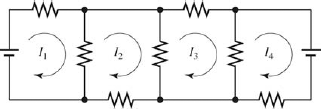Chapter 10. Matrices and Determinants
OBJECTIVESWhen you have completed this chapter you should be able to
|
In the preceding chapter we learned how to solve sets of equations graphically and by a few algebraic methods. Here we give other powerful tools—matrices and determinants. We will see that they are more useful than our other methods for systems of more than three equations.
For example, we saw in the preceding chapter that analysis of a two-loop network gave a system of two equations. Similarly, a four-loop network (Fig. 10-1) would result in a system of four equations, perhaps something like these.
- 57.2I1 + 92.5I2 − 23.0I3 − 11.4I4 = 38.2
- 95.3I1 − 14.9I2 + 39.0I3 + 59.9I4 = 29.3
- 66.3I1 + 81.4I2 − 91.5I3 + 33.4I4 = −73.6
- 38.2I1 − 46.6I2 + 30.1I3 + 93.2I4 = 55.7
Figure 10.1. A four-loop network.

How would you solve this system? We will show how in this chapter.
We will start with some definitions pertaining to matrices, followed by a powerful matrix method for solving systems of equations. We will show how to evaluate the smallest determinant and how it can be used to solve a set of two ...
Get Technical Mathematics, Sixth Edition now with the O’Reilly learning platform.
O’Reilly members experience books, live events, courses curated by job role, and more from O’Reilly and nearly 200 top publishers.

